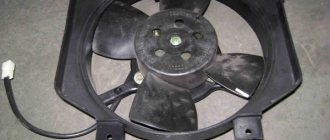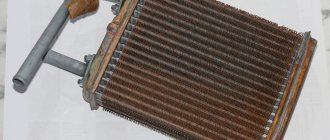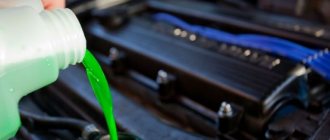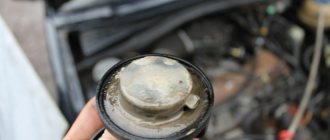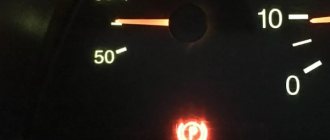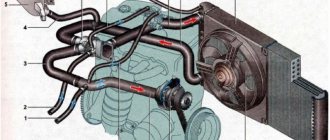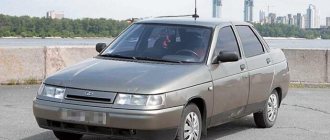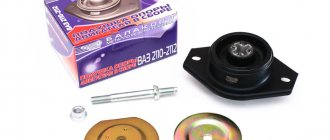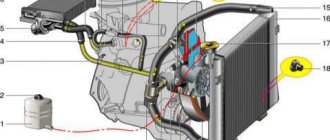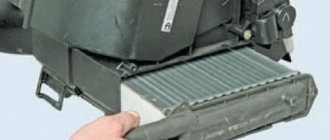Of course, all VAZ-2110 drivers are well aware that only 23% of the thermal energy that is released in our combustion chamber is beneficial. That is, less than a quarter of all heat is converted into kinetic energy. The rest of the heat simply warms the engine and escapes into the atmosphere. And, of course, everyone understands that the faster this excess heat is removed from the engine, the more efficiently it will work . This is why our top ten have introduced a liquid cooling system.
We flush the VAZ-2110 engine cooling system
It is known that in the cooling system of any car engine, including the VAZ 2110, there is a special chemical substance - antifreeze, which is necessary to maintain the engine in a certain temperature range. High temperatures cause deposits of various salts and other contaminants to accumulate in the system. Therefore, it needs to be washed from time to time.
When to flush
During operation, the radiator of the cooling system may become clogged. Moreover, it comes from the outside and from the inside. Today, manufacturers are trying to use higher quality materials, but even they do not protect against corrosion and scale.
If the antifreeze used is not replaced in time, it can also negatively affect the condition of the unit. A complex of such phenomena leads to the cooling system becoming dirty and in need of urgent cleaning.
It is not difficult to determine contamination of CO (cooling system) by a constantly overheating engine, regardless of weather conditions.
The frequency of flushing directly depends on operating conditions, engine condition, CO components used, etc.
Why and how often is the VAZ 2110 cooling system flushed?
The VAZ-2110, like most domestic cars, is very susceptible to the harmful effects of scale accumulated in the channels and pipes of the radiator. These deposits make it difficult for coolant to circulate through the system, causing the engine to overheat. You can prevent unpleasant consequences only by flushing the pipes.
You've probably noticed how antifreeze darkens when it's time to change it. This is because the car radiator gets dirty. A side effect of this phenomenon is an increase in fuel consumption. The “stove” also stops working normally, since it is directly connected to the cooling system.
You say: “Why is this so, because antifreeze is not water, where does the scale come from?” Of course, non-freezing liquid does not cause scale, but if you do not change it in a timely manner, but only top it up, then over time the additives that are part of the antifreeze will begin to disintegrate, depositing a thick layer of plaque on the walls.
Types of cleaning
Cleaning the engine cooling system is divided into two types.
- External. In this case, the procedure includes removing accumulated dirt, dust, and insects from the surfaces of the unit. Use regular pressurized water and car shampoos.
- Internal. This is a more drastic measure in which internal contamination of the system is removed, scale, rust, and debris accumulated there are removed. The work takes a lot of time and effort, but without this you will not be able to eliminate the problem of engine overheating.
Very often the system becomes dirty for a trivial reason - beginners use plain water as a coolant. Due to the presence of a large number of impurities, deposits form almost immediately on the walls of the radiator, heat transfer deteriorates, and the car has to be repaired.
Article on the topic: Self-replacement of the master brake cylinder on a VAZ 2114
Traditional methods of flushing the engine cooling system
Let’s immediately make a reservation that the radiator and engine are washed with different liquids. It is not advisable to use acid solutions to flush the engine, since many parts in it are made of aluminum alloy, which cannot withstand the effects of such liquids. Moreover, the system is harmed by two things: metal corrosion products and antifreeze decomposition products, and these pollutants are cleaned out with different solutions. Therefore, no special auto chemicals will immediately clean the car of all contaminants. We offer you the following cleaning methods.
Lemon acid
You will need no more than 300 g of citric acid per 10 liters of water. It is better not to overestimate the acid concentration for the reasons described above. If the car is not older than three years, no flushing is needed, just change the antifreeze.
What do we have to do:
- First we drain the old “anti-freeze”.
- Instead of used antifreeze, fill in a solution prepared with clean water.
- We start the engine, warm it up to operating temperature (not higher than 90 degrees, otherwise the acid will react with everything it comes into contact with).
- You can drive in this mode for a couple of kilometers.
- After 40 minutes of operation, the solution is drained. The motor is washed with clean water.
Coca-Cola is coming to us!
Do you think the cooling system cannot be flushed with carbonated water? It turns out that it is possible, and how! Coca-Cola is perfect for this purpose, especially on domestic cars. Surprisingly, even experienced car enthusiasts do this and it does not lead to any bad consequences.
The algorithm is similar to the previous one, with the difference that the operating time of the motor “under cola” can be reduced and nothing needs to be diluted in water. Well, before pouring soda into the system, it must be “degassed”, that is, wait until the carbon dioxide leaves it. Afterwards it is quite possible to fill in fresh coolant.
What's in it?
So, you purchased a car and don’t know what exactly is in the cooling system. If there is water or already used coolant there, this does not bode well for your engine.
Therefore, first of all, check whether there is any coolant in the engine at all, and what exactly it is. At the same time, make sure there are no leaks from the pipes or radiator.
It is not difficult to independently determine the type of fluid used by the old owner.
- Antifreeze almost always has a blue or blue color.
- Antifreeze is mainly available in red or green. Moreover, there are a huge variety of shades of red.
- It is not difficult to distinguish water from blue or green liquid.
- If the color of the coolant has a characteristic shade of rust, then this indicates the need for urgent replacement.
Green antifreeze
Mixing different coolants. Yes or no?
In some cases, the quality of the fluid is good enough that it is not necessary to replace it. Only the quantity is somewhat below the required level.
Let's say you have antifreeze filled, but you only have antifreeze on hand. What to do in such a situation? Many VAZ 2114 owners are interested in whether it is possible to mix different compounds.
Antifreeze or antifreeze
There is no consensus on this matter. Let us say for sure that a disaster will not occur from mixing, antifreeze and antifreeze will not react and will not explode the car. But we definitely cannot recommend combining two types of coolant in one tank. Follow the instructions in your car's manual, fill in what the factory recommends, and then you won't have any problems.
Antifreeze is simply a type of antifreeze developed in Soviet times for Zhiguli cars. This was done due to the low quality of the antifreeze offered at that time. Since then, antifreeze is the number one choice for VAZ.
How to properly rinse with special products
Good auto chemicals do not harm the engine and effectively remove contaminants. They come in three types: acidic, alkaline and two-component. To flush the system with a special solution, it is desirable to have distilled water. It is to this that a specialized additive from Hi-Gear or another manufacturer is added. After this, the engine is left to idle for about 10 minutes and the spent solution is drained.
What to do:
- Remove the expansion tank plug.
The plug is removed from the expansion tank
There is a hole in the cylinder block for draining antifreeze
Detailed replacement instructions
Next, we present the sequence of operations with a detailed photo report:
- We carry out the replacement on a well-warm-up engine.
- It is advisable to drive the car onto a lift or inspection ditch
- Open the filler cap
Remove the filler plug
- This will help prevent the formation of a vacuum in the engine housing and thereby ensure the most complete drainage of oil
- Take the key 17 and unscrew the plug from the oil pan
- We first substitute the container we prepared in advance
Take a 17mm wrench (or a 17mm socket with a wrench) and unscrew the plug from the pan
- Draining used oil from the engine
- We advise you to perform this operation carefully, the lubricant is hot and you can get burned.
- When unscrewing, it is better to use a long wrench with a handle (or a socket with a long wrench) and let the plug simply fall into the working container.
- Remove the cork after it has cooled down
- The duration of oil draining into the container is at least 10 minutes or until the stream of oil disappears from the pan
If you decide to flush the engine, now is the time, if not, just skip this point:
- Fish out and screw the plug back into the pan
- Fill flushing oil through the filler neck to the minimum mark on the dipstick - level meter
- Let the engine run for ten minutes, then drain the flush and proceed to replacing the filter
- Take the oil filter wrench and unscrew the filter
Unscrew the filter using a special wrench
- If you don't have such a key, use a strong screwdriver or awl
- We punch the filter housing in a direction perpendicular to the fitting located inside the filter (we punch it away from the motor so as not to touch this fitting) and unscrew it by rotating the handle of the screwdriver used
We pierce the filter with a screwdriver (away from the motor and perpendicular to the fitting) and unscrew it, using the screwdriver as a lever
- Let the oil drain completely from the fitting
- Wipe the filter seat and around it with a rag
- Before installing a new filter, fill it with fresh engine oil to approximately half capacity, and then lubricate the rubber O-ring of the new filter
- This will protect the lubrication system from air entering when starting the engine and protect its parts from operating without lubrication.
Pour fresh oil through a funnel into the new filter to about half the volume, lubricate the rubber O-ring
Air lock: what is it and how to remove it
An air lock may appear in the cooling system - usually this is the result of incorrect actions to replace antifreeze. To remove this interference you will need a screwdriver.
An air lock can quickly cause the engine to overheat. It can occur not only when replacing the coolant, but also when the system is depressurized (the hose is poorly fitted, the clamp is not secured).
This trouble is eliminated as follows:
- Remove the expansion tank plug.
- Locate the antifreeze inlet and outlet hoses.
- Apply several sharp pressures to the hoses. The air should come out.
- Close the expansion tank and start the engine.
Nuances of flushing work on a VAZ (video)
For a car older than three years, flushing the cooling system may be mandatory. It is also better to deal with it after purchasing a used car second-hand, since it is unknown what the previous owner poured into the radiator and expansion tank.
Source
Why does pollution appear?
Purchasing a VAZ-2110, like any other car, involves systematic maintenance, prevention and repair of failed parts. Fortunately, the VAZ-2110 is not equipped with electronics, so every driver can understand the mechanics.
The reasons for the formation of pollution can be the following factors:
- Instead of flushing the system, car enthusiasts prefer only to replace the antifreeze or top it up, while the new material, without removing the contaminants, turns black again within a week. It's all due to a dirty radiator.
- Dust gets not only onto the radiator, but also onto internal surfaces and parts. Accumulating from the inside, rust and engine oil form scale, and therefore the radiator cannot cope with cooling the engine. Without temperature regulation, the radiator quickly fails.
How to flush the VAZ-2110 engine cooling system
The VAZ-2110 engine cooling system consists of a skillful combination of mechanisms and components where the movement and circulation of water or chemicals occurs.
In this aggressive environment, sooner or later scale and salt deposits appear, formed under the influence of high temperatures. Over time, deposits move away from the pipe walls and enter the cooling elements. The consequence of contamination is disruption of the rotation of the coolant and the final stop of the entire cooling system. The heating of the VAZ-2110 engine depends on the quality and features of the cooling process; if the cooling leaves much to be desired, it quickly heats up and the heater turns off. To exclude this scenario, it is enough to thoroughly rinse the clogged structural elements; you can do this yourself.
Cleaning and flushing the radiator of the VAZ 2114/15 stove
You can increase the efficiency of the stove by cleaning and flushing the radiator. The procedure can be performed without dismantling the radiator or with dismantling it. In the first case, you will need to remove the outlet and inlet pipes from the heater and pour a cleaning solution into it. Citric acid, plumbing cleaners (for example, “Mole”), etc. are used as such a solution. Then the radiator is washed with running water and coolant is added. You can clean the radiator better by removing it from the car. This will allow you to wash it not only from the inside, but also from the outside, removing dirt between the honeycombs. Washing is usually carried out with running water.
If after performing these procedures the stove does not work better, the radiator must be replaced.
Video: flushing the stove radiator
Thus, diagnosing a malfunction and determining the cause of poor heating of the VAZ 2114/15 interior with your own hands is quite simple. Self-repair and replacement of individual elements of the heating system are also not very difficult. It is enough just to strictly follow the recommendations of specialists.
With the onset of cold weather, car owners often find that their car's interior heating system is not working efficiently. Everything seems to be fine, but the air coming from the deflectors is not warm enough. This problem may be an indication that the car’s heater core is clogged and cannot pass the required amount of heated coolant through it.
What to do in such a situation: replace the heater or try to repair it? Do not rush to resort to radical measures. If the heat exchanger does not leak, it can be repaired.
In this article we will talk about how to flush the heater radiator without removing it from the car. In addition, we will discuss which products are best suited for this procedure.
Engine cooling system flushing technology
To flush the engine cooling system in a VAZ-2110 with your own hands, you must follow the step-by-step instructions:
- Open the filler cap of the expansion tank.
- Place a container under the engine to drain the fluid.
- Remove the bolt from the drain hole located on the cylindrical block.
- The antifreeze that begins to pour out must fall exactly into the container, and not past it.
- When the flow of antifreeze stops, unscrew the cap, which is located at the bottom of the radiator, and again pour the liquid into the container provided.
- Put the plugs in place and pour distilled water inside, adding additives - a substance that will get rid of scale. Alternatively, you can add Hi-Gear product.
- Now rinse the system thoroughly with water, mixing it with the cleaning component. If something does not come out by gravity, it is recommended to clean the surface by exposing it to water pressure. To do this, disassemble the pipeline, freeing the upper component and the base of the radiator from the pipe. As soon as clear liquid flows at the bottom of the radiator, the flow of water can be turned off. This completes the procedure.
What can I use to wash it with?
There is now a wide range of cleaning products available. The most accessible of these is water. However, it is also the least suitable remedy. Due to the salts present in the water in a dissolved state, scale may form after washing, which in the future will cause contamination and repeated cleaning. For this reason, you should use only distilled or, as a last resort, boiled water.
Special cleaning fluids
The range of cleaning liquids of various compositions and concentrations is quite extensive. Most of them allow you to efficiently clean the engine cooling system. But the choice of product should also be taken seriously, since different types of dirt require substances of different compositions to remove.
Cleaning products can be divided into 4 categories:
- Neutral - do not contain aggressive components, are less effective in cleaning the cooling system than other liquids, and are most often used for preventive purposes.
- Acidic - almost never found in pure form due to their extreme aggressiveness to system parts. Acidic flushing fluids are well suited for neutralizing scale and inorganic deposits.
- Alkaline - like the previous category of substances, are not found in an undiluted state. Effectively removes organic contaminants.
- Two-component - contain both acid and alkali. They are consistently poured into the system and thoroughly clean it of all types of contamination.
Coolant racks
It is better not to use two different products at the same time, since the acid and alkali are neutralized during interaction, which may not only not bring the expected result, but also cause a malfunction. You should also not use substances with high concentrations of acids or alkalis, as they can damage rubber and plastic parts.
Lemon acid
One of the popular “improvised” cleaning agents is a solution of citric acid. If the correct proportions are observed, it copes well with scale inside the radiator and does not damage rubber components. The optimal ratio is 100 g of acid per 1 liter of water.
Citric acid can be replaced with whey. It contains a concentration of lactic acid sufficient for effective and gentle cleaning. Also, flushing with serum is more gentle on non-metallic parts of the radiator.
As is the case with compositions specifically designed for cleaning, it is better to carry out the process itself in several short steps - this will help to avoid breaking off large pieces of scale.
Cleaning OS with serum
"Coca-Cola" and the consequences of such washing
Another common cleaning product. The orthophosphoric acid contained in the drink effectively removes scale from internal parts
However, this product should be used with caution, because in addition to the aforementioned acid, Coca-Cola also contains sugar, which can clog the system. Therefore, after using Coca-Cola, it is necessary to re-clean the system with water to remove any remaining sugar.
The concentration of phosphoric acid has a negative effect on rubber and parts.
Another disadvantage of Coca-Cola as a cleaning liquid is its gas content. Gas expansion due to heating during engine operation can lead to negative consequences for the vehicle. Therefore, if you nevertheless decide to use Coca-Cola as a cleaning liquid or do not have the opportunity to use more suitable substances, you need to get rid of the gas it contains.
Coca-Cola for flushing the cooling system
Keeping the engine cooling system clean is one of the important factors in the health of the car. For this, a wide range of specialized cleaning liquids are available, which, if chosen correctly, will help maintain the optimal condition of this system, as well as all sorts of available alternatives.
But when using the latter, you should be careful and resort to them in the absence of more suitable substances
Cooling system flushing products
When flushing the VAZ-2110 engine cooling system with their own hands, owners use one of the following:
- Distilled water is still popular among car enthusiasts, but auto mechanics say that you should not expect good results. Simply put, this is just deceiving oneself - a larger volume of contaminants still remains on the inner walls of the pipeline. First you need to drain the old coolant and fill it with new one. Start the engine and leave it running for 10-15 minutes, then turn off the engine and drain the distilled water into a container. This cycle of repetitions is carried out until clean, clear water comes out of the bottom of the engine. The disadvantage of this method is the increased risk of scale formation on the walls.
- Acid, soda and vinegar. The components should be mixed and added to distilled water. Aggressive components are able to soften contaminants, so the effectiveness of this technology is much higher than in the previous version. To prepare a cleaning solution for the VAZ-2110 engine cooling system, you will need caustic soda (baking soda will be absolutely useless), lactic acid and ordinary table vinegar. Just a little bit of lactic acid is needed.
A large amount of the substance can destroy rubber gaskets and other elements of the cooling mechanism.
Leave the car for 8 hours, during which time the acid solution will thoroughly soften the dirt; for best results, periodically start and stop the engine. Afterwards, the liquid needs to be drained into a container, pour distilled water again, but without fillers, and perform the manipulations described in the previous method. 1-2 washing cycles are enough to remove acidic residues, and along with them, dirt. Don't forget to add new antifreeze. To prevent aggressive components from harming the driver’s health, for example, causing burns, it is advisable to use protective equipment in the form of special gloves.
- Every experienced service station worker will say that there is no better store-bought car detergent for cleaning the engine cooling system. Manufacturers took care of the balance of all components that are present in the solution, taking into account the safety of use for the machine and human health. But here the car enthusiast is in for an unpleasant surprise - professional solutions are not cheap. Manufacturers suggest using neutral, acidic, two-component or alkaline products. Alkaline and acidic products offer drivers a high level of performance and are less expensive.
Stages of replacing coolant VAZ 2106
On most classic Lada cars, drainage is provided from the radiator, as well as the engine. But before adding new antifreeze, it is recommended to flush the cooling system to prevent impurities from getting into the new liquid.
During the production of the VAZ 2106, a large number of modifications were produced, which were equipped with various engines. But at the moment the most popular are petrol versions with a 1.6-liter carburetor.
Before you start replacing the coolant, to avoid getting burned, you need to wait until the engine has completely cooled down. You should also avoid getting antifreeze or antifreeze on the skin, eyes or digestive organs, since the chemical composition of the liquids is toxic.
Coolant drain
Before starting the draining procedure, you should prepare tools, containers for used antifreeze, as well as new liquids for subsequent refilling. If protection is installed under the engine, it can also be removed for convenience.
Next, we perform the procedure for draining the liquid from the VAZ 2106:
- Turn the temperature regulator in the cabin to the maximum position to the right (Fig. 1).
Fig. 1 Temperature control Find the plug in the bottom left corner of the radiator and unscrew it, after placing a drain container under the radiator. (Fig.2). On older versions, this plug is not present; a fan switch sensor is installed there. To drain the antifreeze, you need to unscrew it; this can be done with a 30mm wrench.
Fig. 2 Radiator drain plug After this, unscrew the plug on the radiator filler neck, as well as on the expansion tank, to drain the liquid more quickly (Fig. 3).
Fig. 3 Caps on the filler necks Unfasten the fastening of the expansion tank and lift it up (Fig. 4). In this case, the liquid will drain through the radiator drain hole. And the tank itself can be completely removed and washed.
Fig.4 Fastening the tank To drain the coolant from the engine, you need to unscrew the drain bolt using a 13mm wrench. The bolt itself is located on the left side; you can place a watering can under it to reduce splashing of the liquid (Fig. 5).
Fig.5 Drain bolt on the engine block
Flushing the cooling system
If there are deposits in the drained liquid or there is a transition from antifreeze to antifreeze, the system should be flushed. To do this you need to do the following:
- Flush the system with plain water through the expansion tank of the VAZ 2106. The plugs must be open;
- tighten the drain plug and bolt;
- fill the system with a flushing agent (you can use Liqui Moly Kuhlerreiniger or Lavr cooling system flush) with distilled water (6-7 liters);
- start the engine. Warm up to 90 degrees;
- leave it idling for 5-10 minutes, depending on the contamination of the system;
- muffle it. Allow the engine to cool to approximately 60 degrees;
- drain the flush using the same steps as removing the old fluid;
- tighten both plugs;
- fill with distilled water to rinse the cooling system;
- start the car and warm up to 90 degrees;
- turn off and let cool to 60 degrees, drain;
- repeat steps 8, 9, 10 and 11 if necessary.
Filling without air pockets
To fill new fluid into the cooling system, you can use the instructions described in the book on car repair and operation. But when doing this, motorists very often end up with air jams.
So, let's start filling it correctly:
- First you need to remove the rubber hose from the fitting above the intake manifold (Fig. 6).
Fig.6 Rubber hose
The drain plug on the radiator should be closed and the drain plug on the engine block should be open. We begin to pour antifreeze into the radiator. As soon as it flows from the hole on the block, screw the bolt into place. We continue to fill in the antifreeze until it flows out from the place indicated in Figure 6. After this, we put the hose in place. Now fill the radiator to the top of the neck and screw on the cap. Fill the expansion tank a few centimeters above the MIN mark. We start the car, warm it up to operating temperature, let it run for 5 minutes, then turn it off.
Thus, the filling of coolant without the formation of air pockets is completed. All that remains is to wipe off the spilled antifreeze and wait for the engine to cool. With the car now cooled down, check the level in the expansion tank again and top up if necessary.
Expert advice
The operation of the VAZ-2110 cooling system depends not only on timely flushing, but also on other equally important characteristics. Specialists involved in the repair and restoration of cars of various classes and brands recommend following the following operating requirements:
- Don't skimp on the quality of antifreeze. Antifreeze, which is most often poured into the VAZ-2110, reduces the period of active operation of the car. If it breaks, repairs will cost much more.
- Make it a rule to carry out flushing as planned - once a year is enough, 2 times a year is ideal.
- Monitor the condition of the cooling solution and change it completely.
- If your gut feeling tells you that it’s time to wash the parts, don’t delay it. Taking good care of your car will eliminate many problems and prevent new ones.
The effect of flushing the cooling system with Coca-Cola
Another completely unusual solution is to rinse the SOD with Coca-Cola, but for some reason it seems strange to many that the drink can corrode dirt. But there is still an explanation for this chemical reaction: the “soda” contains orthophosphoric acid (acidity regulator). According to some drivers, Coca-Cola actually helps to wash the inner walls of the radiator and is not the worst flushing agent. But before using this composition, you must open the bottles of liquid and wait until the gas is completely released from them.
For rinsing, the Coca-Cola drink is not diluted with water, it is filled entirely, which means that to refill a 10-liter PO you need to buy five large bottles of lemonade. But is it worth experimenting with such an unusual product for a car, when there are a lot of proven compounds, as well as certified products specifically designed for these purposes?

